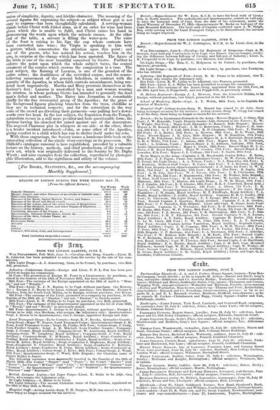THE ARUNDEL SOCIETY.
A new instalment of the wood-engravings from Giotto's frescoes in the Arena Chapel at Padua has been published by the Arundel Society, num- bering from the twenty-third to the twenty-sixth of the series. We have before spoken of the unsurpassable nobility of these works in the history of art; and, fortunately, all who are not scared by false perspective and deficient drawing from contemplating the soul of a great work have the opportunity of profiting by a study of the productions in the tracings and drawings of them on view at the Crystal Palace.
The twenty-third plate represents the miracle of Cana, with a striking union of simplicity, dignity, and lifelike character. The meaning of the several figures for expressing the subject—a subject whose gist is not easy to express—has been thoughtfully calculated. A serving-woman stfulds before Christ with folded arms, as if an order for wine had been given which she is unable to fulfil, and Christ raises his hand in pronouncing the words upon which, the miracle ensues. At the other end of the table, a servant is filling the water-pots. The ruler of the feast is raising to his lips the cup whose contents have been converted into wine ; the Virgin is speaking to him with
gestute 'which concentrates the attention upon this point ; and one of the guests, who has noticed his action, touches him on the arm, in surprise at the change which has been operated. The figure of the bride is one of the most beautiful conceived by Giotto. Further to enforce the point upon which the whole subject turns, the central ornament of the cornice which crowns the composition is a vase. The next subject, the Raising of Lazarus, is one of the grandest of the entire series ; the deathliness of the revivified corpse, and the scarce- believing amazement of the general beholders, in contrast with the serenity of the Apostles, in whom faith controls astonishment, being ren- dered most impressively. Martha and Mary prostrate themselves at the Saviour's feet: Lazarus is unswathed bx a man and woman wearing the nimbus, in whom perhaps Giotto has intended to personify the dead man's father and mother. The Entry into Jerusalem is remarkable chiefly for the fine reverential group of the Apostles ; for the grace of the background figures plucking blanches from, the trees, childlike as they are in technical respects ; and for the naturalism in the way some of the crowd are divesting their garments—one pulling her'e down- wards over her head. In the last subject, the Expulsion from the Temple, naturalism recurs in a still more peculiar and here questionable form; the Saviour having his clenched fist raised against one of the desecrators. The angered Pharisees plot in whis rs at one side : at the other, there is a tender incident introduced—J , or some other of the Apostles, giving comfort to a child which has run to shelter itself under his robe. With these engravings, the Society issues a handsome little book on the interesting Collection of fac-simile ivory-carvings. irt its possession. Mr. Oklfield's catalogue raisonne is here republished, preceded by a valuable lecture on the history, methods, and chief productions, of the ivory-car- ver's art, which was originally delivered to the Society by Mr. thgby Wyatt ; and nine examples from the collection, reproduced by photogra- phic illustration, add to the sightliness and utility of the volume.



































 Previous page
Previous page